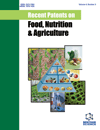Recent Patents on Food, Nutrition & Agriculture - Current Issue
Volume 12, Issue 2, 2021
-
-
Application of Nutraceuticals in Managing Osteoarthritis and Osteoporosis
More LessAuthors: Pankaj Musyuni, Deepak Kumar, Deepti Pandita, Gaurav K. Jain, Manju Nagpal and Geeta AggarwalBackground: Several health problems, especially musculoskeletal disorders, are caused by differences in work cultures and human lifestyles around the world. While the conventional approach to treating such conditions emphasizes a balanced work-life and daily exercise, nutraceuticals have proven to be successful. Nutraceuticals are dietary compounds that help sustain cartilage metabolism homeostasis, reducing articular p Read More
-
-
-
Aloe vera Compositions Used for Medicinal Applications: A Patent Review (2013-till 2020)
More LessAuthors: Bhushan D. Varpe, Amol A. kulkarni and Anil S. MaliBackground: Aloe vera is a plant traditionally used for medicinal purposes. It is also used as a cosmetic. Aloe vera gel/extract/juice is used in hair care, moisturizing, cleansing, and thickening agent in formulations. Aloe vera gel is rarely used for burns, wounds, infections, and gastric diseases. Objectives: To study the patents filed recently and understand the trend in the application of Aloe vera for therapeutic purposes. Method Read More
-
-
-
Diet Supplementation with Madagascar Cockroach Flour (Gromphadorhina portentosa) Improved Malnourished Mice Metabolism and Ameliorated Liver Inflammatory Markers
More LessBackground: Malnutrition and accessible high-quality protein food sources are two of the world’s alimentary challenges. Edible insects are nowadays recognized as a possible functional food solution with lower environmental impacts and beneficial health effects. Objective: In this context, the aim of the present study is to evaluate Madagascar cockroach (Gromphadorhina portentosa) flour supplementation effects Read More
-
-
-
An In Vitro Study on the Effects of Selected Natural Dietary Fiber from Salad Vegetables for Lowering Intestinal Glucose and Lipid Absorption
More LessBackground: Salad vegetables are good sources of dietary fiber and are becoming increasingly popular among consumers. Therefore, these plants have the potential to be developed as functional foods. Objective: Using an in vitro model, this study investigated the physical properties and intestinal glucose and lipid absorption capacities of dry dietary fiber from vegetables typically consumed in salads (types of lettuce, inclu Read More
-
-
-
Profiling of Essential Mineral Content, Heavy Metals, and Bacterial Contaminants in Conventional and Organic Eggs Available in the Hypermarkets of the Eastern Province of Saudi Arabia
More LessAuthors: Saad Dahlawi, Mahmoud Berekaa, Khaled Salama, Ossama Labib, Saifullah, Waqas Asghar and Nauman KhalidBackground: Eggs are commonly regarded as one of the best sources of various macro and micronutrients, in particular, high biological value (BV) proteins and both saturated and unsaturated fatty acids. Apart from proteins, eggs are excellent sources of various high health value lipid components, carotenoids, minerals, and both water and lipid-soluble vitamins. However, the nutrient-rich nature of this ‘superfood’ also Read More
-
Most Read This Month Most Read RSS feed
Article
content/journals/pfna
Journal
10
5
false
en


